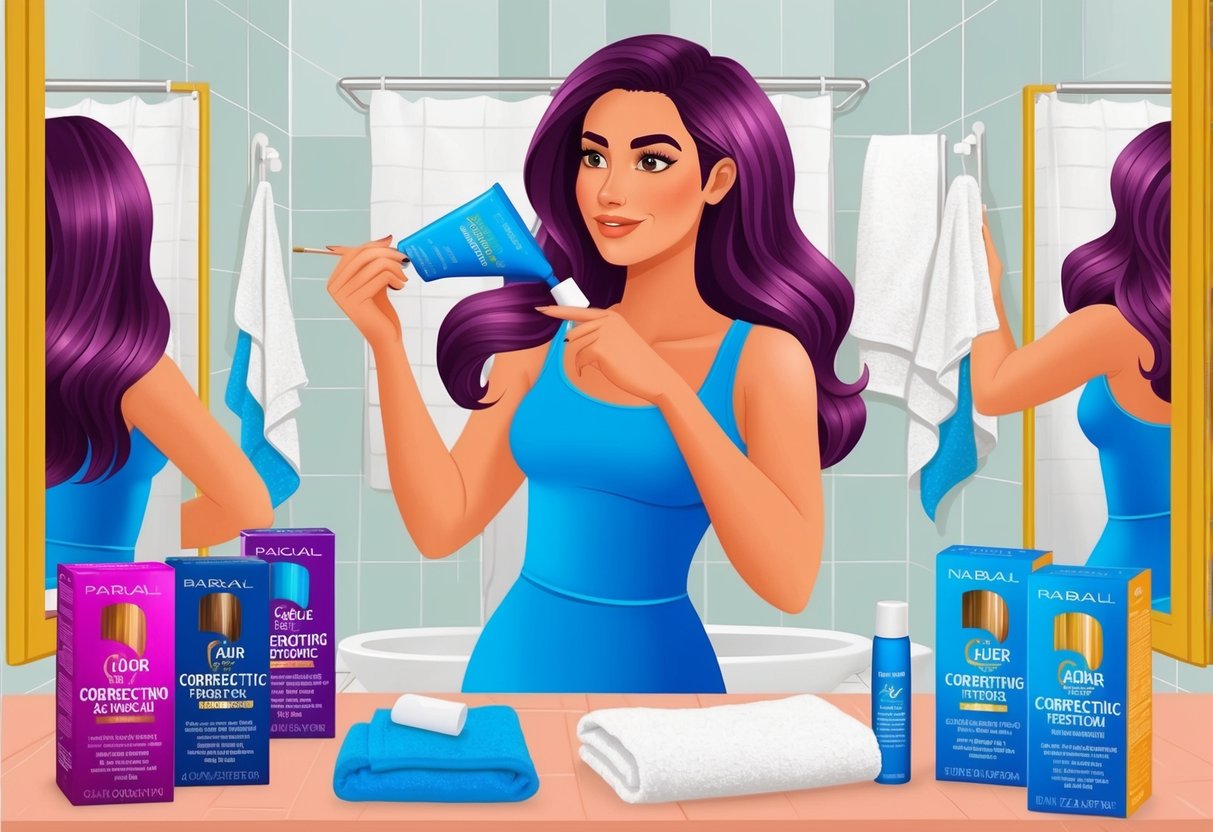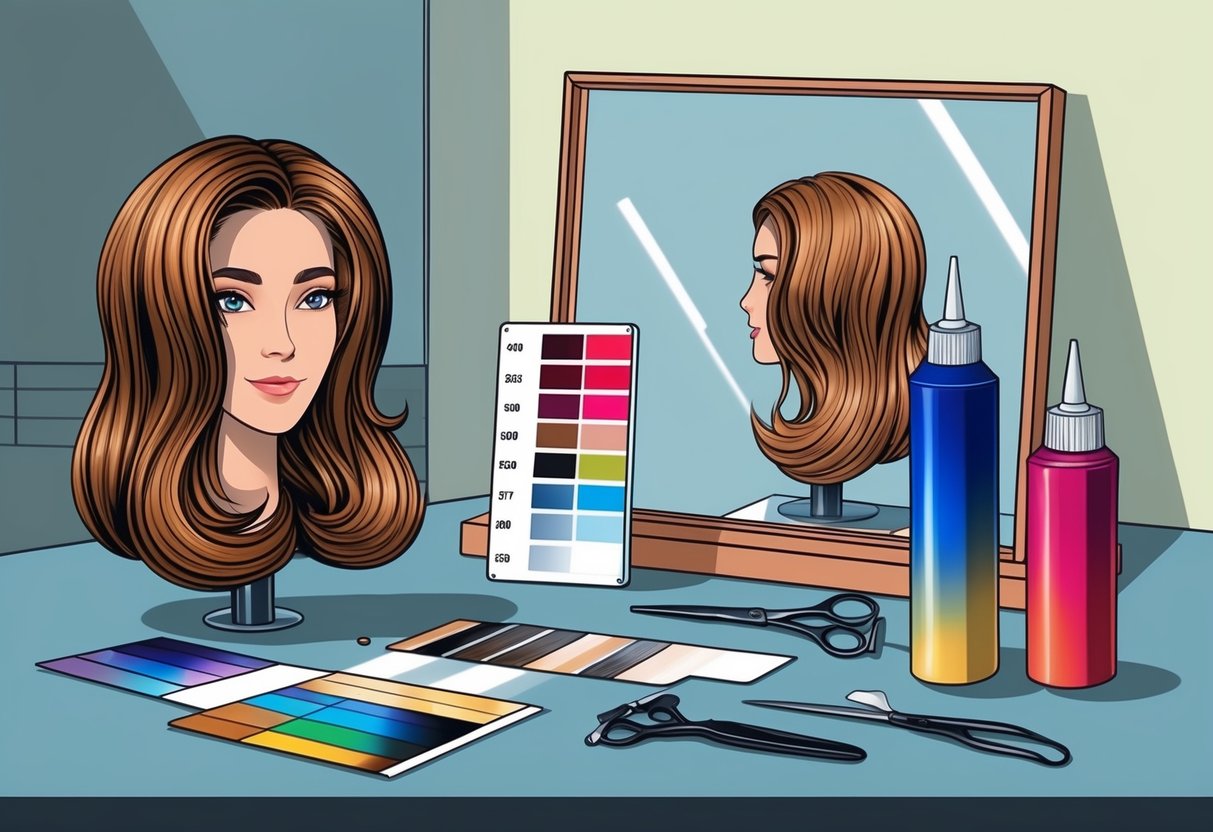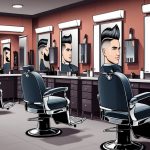
Correcting Brassy, Orange, or Green Tones
Unwanted brassy, orange, or green tones can appear after dyeing hair, often due to underlying pigments or reactions with certain products or minerals.
Effective color correction methods can restore a more balanced, natural shade without the need for a salon visit.
Neutralizing Unwanted Undertones
Brassy or orange tones often show up in lightened hair when yellow and red pigments remain after bleaching, particularly in dark hair.
Green tones usually appear when blonde or bleached hair comes into contact with chlorine or certain hair dye mixtures.
To correct these issues, it’s important to use the color wheel principles.
Blue tones neutralize orange, while purple cancels out yellow.
Red helps counteract green tones.
This process can involve applying a color-depositing treatment in the opposite shade to the unwanted undertone.
Use products such as blue or purple shampoos and conditioners for brassiness.
A red-tinted conditioner or specialized neutralizing treatment can help fix green discoloration from chlorine or chemical buildup.
Routine application may be needed for persistent tones.
Using Toners and Corrective Shampoos
Toners are a key tool for at-home hair color correction.
They are designed to adjust the tone of the hair without dramatically changing the base color.
A demi-permanent or semi-permanent toner with the right pigment can target brassiness and bring the hair closer to the desired shade.
Blue toning shampoos are effective for neutralizing orange, while purple shampoos are best for yellow brassiness.
When correcting green hues, a clarifying shampoo can remove unwanted minerals or buildup.
Sometimes this is followed by a red-tinted remedy to restore warmth.
For stubborn cases, foam gloss treatments or color-depositing masks can offer more intensive toning.
It’s essential to follow manufacturer instructions carefully and alternate with nourishing products to prevent dryness.
For more guidance on how to select and use these products, visit this guide on fixing brassy hair color at home or explore options for removing orange tones from hair.
Dealing with Overly Dark or Light Hair
Both overly dark and excessively light hair color mistakes are among the most common results of at-home hair dye applications.
Each requires a different approach for effective correction.
Using the right technique can help reduce damage and improve color results safely.
Lightening Hair That’s Too Dark
If hair dye has taken too dark, there are several methods that may help lighten the color without excessive damage.
Frequent washing with a clarifying shampoo is a gentle technique; these shampoos can gradually lift some pigment from the hair strands.
Sometimes, using a strong cleansing product, such as a dish soap, can also help to fade the dark color by removing the surface layer of dye.
This approach is suitable for recent applications and often works best in the days immediately following hair color treatment.
For those seeking a more noticeable lightening effect, a color remover designed for at-home use can break down artificial pigments.
While it may not return hair to its natural shade, it often lifts some depth and prepares hair for further toning or recoloring.
Conditioning treatments should follow any lightening efforts to help restore moisture and prevent breakage.
For more guidance on gentle ways to reverse dark hair dye, visit this article on fixing at-home hair dye mistakes.
Darkening Over-Processed Hair
If hair has become too light or over-processed through bleaching or highlighting, darkening and restoring vibrancy can be achieved by carefully selecting the right products.
A semi-permanent or demi-permanent hair color is less damaging than permanent dye and can deposit the right tone back into the hair, often evening out patchiness resulting from previous color mishaps.
Choosing a formula with added conditioning agents can help address dryness and brittleness associated with bleaching.
A color-depositing mask or toner is also effective for toning down unwanted brassiness or yellow tones.
This method allows for a controlled shift in color while minimizing further stress to the hair strands.
Hair masks and deep conditioners should be incorporated frequently to replenish moisture lost during the lightening process.
More details about managing and balancing overly light hair can be found in this guide on fixing highlights at home.
Restoring Highlights and Lowlights

Correcting highlights and lowlights at home often requires targeted products and techniques.
The right approach can bring back vibrancy, add contrast, and create a more polished finish for any hair color.
Fixing Faded Highlights or Lowlights
Faded highlights can leave hair looking dull or unbalanced, and lowlights may lose their depth after several washes.
He or she can use a color-depositing hair mask or toning shampoo to restore vibrancy.
Choose products that match the desired tone, such as purple shampoo for blonde highlights or blue/purple formulas for brassy tones.
Consistent application is important.
Leaving the product on for the recommended time, usually 5–10 minutes, helps revive faded color.
A color gloss can also be effective for adding a hint of shine and correcting uneven tones.
For highlights that appear too warm or yellow, a cool-toned toner neutralizes brassiness.
If lowlights look too light, a semi-permanent hair color close to the original shade can bring back depth.
Always follow instructions and perform a strand test first to prevent unexpected results.
For more details on conservative options for at-home color correction, see these expert tips for fixing highlights at home.
Adding Dimension at Home
When hair appears flat or monotone, adding dimension can help highlights and lowlights blend more naturally.
Individuals can use temporary hair color sprays, root touch-up powders, or even DIY balayage kits.
These products allow for subtle placement of lighter or darker tones without harsh lines.
Applying color in small, strategic sections—focusing on the areas that need extra contrast—improves results.
For best blending, alternate between a highlight and a lowlight shade.
It is essential not to overlap too much, as this may create muddy color or visible bands in the hair.
Gloss treatments and color-refreshing conditioners are also useful for keeping multi-tonal hair vibrant and shiny.
They help maintain the contrast between highlights and lowlights while avoiding damage from permanent hair dyes.
If unsure of product choice or technique, online video tutorials and in-depth articles, such as this guide on color correction for hair, offer guided advice.



